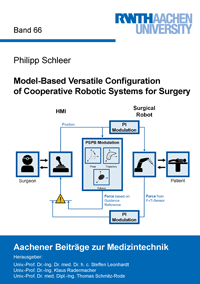
Shop : Details
Shop
Details
48,80 €ISBN 978-3-8440-8149-7Paperback200 Seiten47 Abbildungen278 g21 x 14,8 cmEnglischDissertation
August 2021
Philipp Schleer
Model-Based Versatile Configuration of Cooperative Robotic Systems for Surgery
Machines are characterized by geometric accuracy, able to fuse information from multiple sensors, untiring and immune to radiation and infection. Humans are proficient at interpreting complex information and qualitative data even against high background noise levels. Since these skills are highly complementary, several cooperative strategies are used in surgical robotics to improve the surgical outcome. However, technical realizations vary throughout application fields, and there seems to be no consensus about which realization performs best for a given clinical scenario. To be able to assist the surgeon during an intervention by the best possible means, modular system design seems to be crucial.
Therefore, surgical robotics is analyzed from a human factors perspective to abstract systems and assistance functions for a modular architecture in the operating room. User studies are conducted with respect to the basic haptic guidance functions in simulation environments and a haptic feedback controller for bone surgery is presented. Several strategies to combine artificially generated haptic guidance forces and feedback from the remote environment while avoiding overlapping or masking of forces are investigated. An exemplary cooperative robotic system for surgery is built to validate the research results.
The presented generic robotic device profiles, in combination with the modular assistance functions and their recommendations for use, can foster integration of surgical robots into an open and modular network of medical devices in the operating room. This will enable surgical robots to become more versatile, provide a better benefit-to-cost ratio and increase market penetration. At the same time, usability for the surgeon and ultimately patient care can be enhanced.
Therefore, surgical robotics is analyzed from a human factors perspective to abstract systems and assistance functions for a modular architecture in the operating room. User studies are conducted with respect to the basic haptic guidance functions in simulation environments and a haptic feedback controller for bone surgery is presented. Several strategies to combine artificially generated haptic guidance forces and feedback from the remote environment while avoiding overlapping or masking of forces are investigated. An exemplary cooperative robotic system for surgery is built to validate the research results.
The presented generic robotic device profiles, in combination with the modular assistance functions and their recommendations for use, can foster integration of surgical robots into an open and modular network of medical devices in the operating room. This will enable surgical robots to become more versatile, provide a better benefit-to-cost ratio and increase market penetration. At the same time, usability for the surgeon and ultimately patient care can be enhanced.
Schlagwörter: Surgical Robotics; Shared Control; Haptics; Human-Machine Interaction
Aachener Beiträge zur Medizintechnik
Herausgegeben von Univ.-Prof. Dr.-Ing. Dr. med. Steffen Leonhardt, Univ.-Prof. Dr.-Ing. Klaus Radermacher und Univ.-Prof. Dr. med. Dipl.-Ing. Thomas Schmitz-Rode, Aachen
Band 66
Verfügbare Online-Dokumente zu diesem Titel
Sie benötigen den Adobe Reader, um diese Dateien ansehen zu können. Hier erhalten Sie eine kleine Hilfe und Informationen, zum Download der PDF-Dateien.
Bitte beachten Sie, dass die Online-Dokumente nicht ausdruckbar und nicht editierbar sind.
Bitte beachten Sie auch weitere Informationen unter: Hilfe und Informationen.
Bitte beachten Sie auch weitere Informationen unter: Hilfe und Informationen.
| Dokument |  | Gesamtdokument | ||
| Dateiart |  | |||
| Kosten |  | 36,60 € | ||
| Aktion |  | Zahlungspflichtig kaufen und anzeigen der Datei | ||
| Aktion |  | Zahlungspflichtig kaufen und download der Datei | ||
| Dokument |  | Inhaltsverzeichnis | ||
| Dateiart |  | |||
| Kosten |  | frei | ||
| Aktion |  | Anzeigen der Datei | ||
| Aktion |  | Download der Datei | ||
Benutzereinstellungen für registrierte Online-Kunden (Online-Dokumente)
Sie können hier Ihre Adressdaten ändern sowie bereits georderte Dokumente erneut aufrufen.
Benutzer
Nicht angemeldet
Export bibliographischer Daten
Shaker Verlag GmbHAm Langen Graben 15a52353 Düren
Mo. - Do. 8:00 Uhr bis 16:00 UhrFr. 8:00 Uhr bis 15:00 Uhr
Kontaktieren Sie uns. Wir helfen Ihnen gerne weiter.



